There’s no question that the popularity of learning survival skills, bushcraft, and even off the grid living have really taken off in recent years. Whether it’s getting away from the stresses of life, creating your dream piece of property away from the hustle & bustle, or prepping for if/when SHTF, picking up bushcraft skills is never a bad idea.
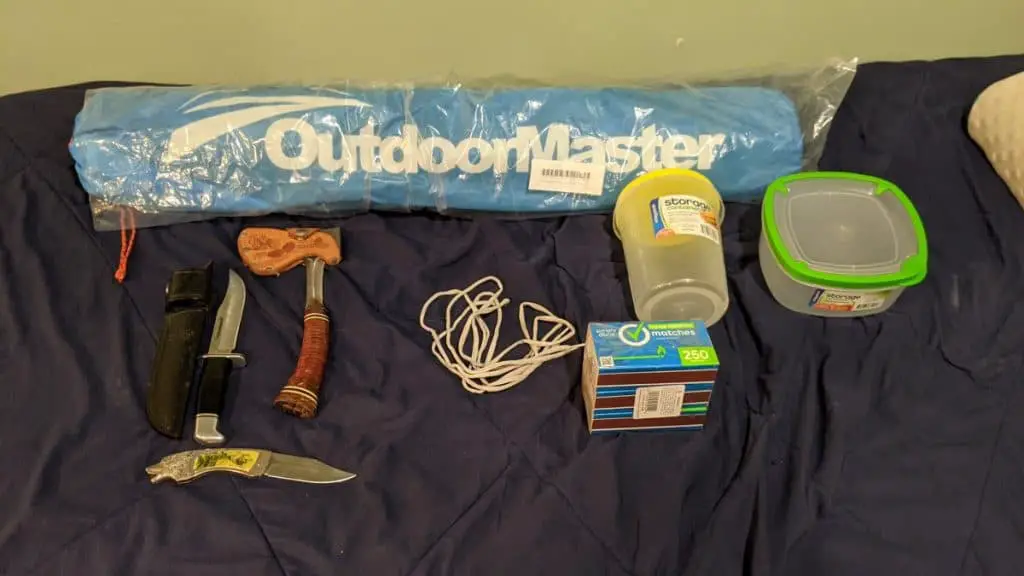
A cornerstone of bushcraft is learning the “5 C’s of bushcraft” which is short for: Cutting tools, cordage, containers, cover, and combustion. All good starting camps start with these five elements in mind.
Learning the 5 C’s of Bushcraft
As you get more experience in bushcraft and survival situations, and see what skills you take to naturally versus which you need to develop, you’ll be able to get creative in your choices for gear you want to pack in.
This is the starting blueprint. We’ll dive into each “C of Bushcraft” and once you learn these foundations you’ll be set to build on them, expand, and create a camp, cabin, or wilderness setup that you love.
5 C’s of Bushcraft Table
| The C | Brief Description | Gear Examples | Reccomendation |
|---|---|---|---|
| Cutting Tools | Any bladed tool that can be used to cut, carve, or otherwise used in a similar capacity. | Camping knife, ax, hatchet, or even pocket knife. | 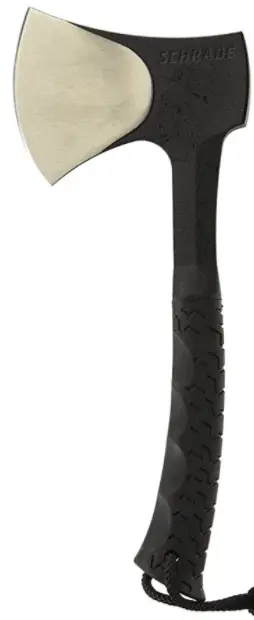 Schrade Camping Hatchet |
| Cordage | Rope, string, cord, or any combination of cordage that can be used for knots or lashings. | Paracord, nylon cord, polyester rope, or rope. | 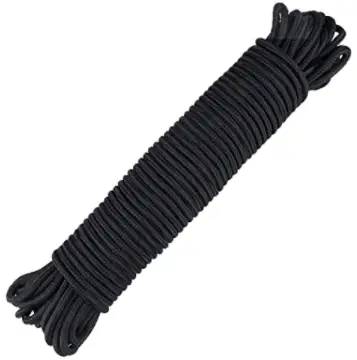 Quality all-purpose black nylon rope |
| Containers | Any containers great for storing water or keeping stuff dry from water. | Tupperware, canteen, any waterproof container that can hold water. | 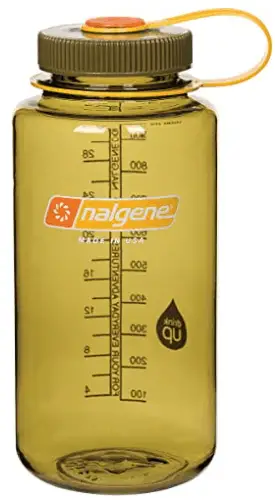 Nalgene Water Bottle |
| Cover | Coverage is anything that keeps you warm or protects you from the environment. | Tarp, sleeping bag, tent, wool blanket all count. | 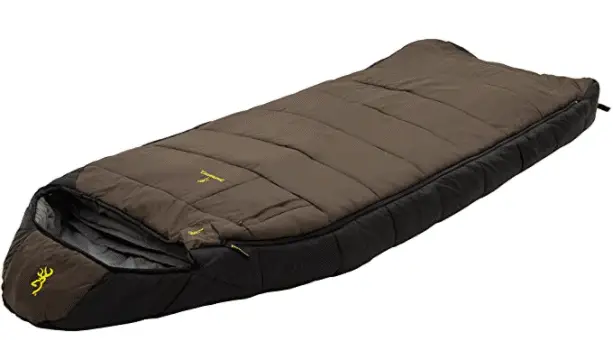 Browning Camping McKinley Arctic Sleeping Bag |
| Combustion | Combustion tool or “anything to start fire.” | Matches, lighters, flint & steel, fire stick, solar firestarter | 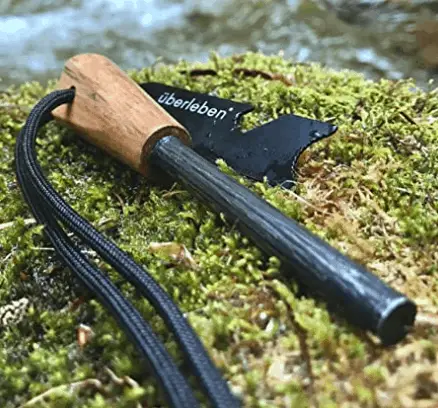 Uberleben Zunden Fire Starter |
For more information on each part of bushcrafting just continue reading on!
Cutting Tools
Oh yeah, you gotta have the right tools for the job! Cutting tools are the first C for bushcraft. This is true for prepping, wilderness survival, or most outdoor activities where you may find yourself isolated. That main picture is my favorite Buck knife, favorite pocket knife, and hatchet that’s good enough until I get a new one.
Cutting tools are an absolute necessity. While primitive skills like creating a razor sharp knife from two stones is super cool, it’s also not something to depend on.
What if you don’t have the right rocks? What if you need a tool to take down small trees? Why put yourself in a higher likelihood of injury? Making those stone knives is not 100% safe.
Cutting tools are a necessary part of so many tasks, especially when building a long-term camp, cabin, or setting the stage for this in the future. I think a pocket knife, large fixed blade knife, and hatchet is the absolute minimum.
For a planned excursion I would also have a good machete or axe at a minimum.
Recommended Gear: As stated above, depending on what you’re doing there’s the bare minimums, and then the ideals. Look I’m also sort of a knife fanatic and probably going to go overboard, but if you want a fully array of amazing cutting edges, here are my recommendations (links to listing on Amazon.com)
- Best Full-Sized Camping Axe: Fiskars Wood Splitting Ax
- Best Non-Specialty Machete: Hooyman Bush Machete
- Best Fixed Blade Knife: Ka-Bar Marine Combat Knife
- Best Camping Hatchet: Schrade Camping Hatchet
- Best Pocket Knife: Buck Knife Pocket Knife
Cordage
Whether making a hammock, shelter, or tarp to catch rain, you’ll need rode. Having various sizes and types of cordage means you can make all the knots, bindings, and lashings you need.
If you spent a youth in scouts then you know just how important this knowledge is…and how much more rope you need than you originally thought.
This is one of the most common mistakes that beginners make. While there are ways to use sliced bark or vines to create cordage in a snap there are a few major problems with this, like:
- The strength of the handmade cord will almost certainly be less
- This damages nearby trees and in the long term can even lead to their deaths
- This is harder than it looks – especially to do it well
If you show up with enough cordage ahead of time you won’t have to worry about these issues and you will have far more options that are available to you.
Recommended Gear: Different types of cordage is never a bad idea. While versatile things like paracord can be great in a pinch, having multiple cord types can really give you the full array of options you want in any bushcraft situation. All links to listing on Amazon.com or other appropriate site.
Containers
Containers mostly serve one of two purposes, and sometimes both depending on what is needed at the time. One is to store, create, or manage water. The other is to keep gear safe from water via waterproof containers.
This means you have quite a variety of options when it comes to figuring out which containers are best to use when you are preparing your camp.
From the incredibly cheap and already in your cupboard to getting some containers specifically designed for long-term outdoor use, you have options.
Water is critical when you’re in an outdoor camp setup or a bushcrafting camp setup, and the right containers are a necessity to make sure you have enough clean water.
If your containers can keep enough water to meet all your needs while also being versatile enough to take care of other needs then you will be all set to go.
Recommended Gear: Containers to carry food, water, or other supplies that you don’t want exposed to the element is crucial here. Keep in mind environment. New Tupperware works to stash stuff in Iowa. If you’re in bear country, the bear cannister is a must. All links to listing on Amazon.com or other appropriate site.
- Great Bear Cannister: UDAP no-fed bear resistant canister
- Thru Hiker Favorite: Nalgene Tritan water bottle
- Cheap Tupperware Works (Stopgap): Red lid Tupperware
Cover (or Cover Elements)
Climate is a danger whether it’s too hot, too cold, both, or it’s rainy and you need shelter. Good cover matters to stay relaxed when the weather changes, protect your core body temperature, and offer you a good night’s sleep.
You want to make sure that you are prepared for both the short-term and long-term depending on your specific situation.
I’m all about bringing in a tent from moment one, along with a tarp, a wool blanket or cheap quilt (if you’re not going with a classic camping sleeping bag) and some spare cloth in case I need another layer under me or over me.
Cover matters. Many times cover matters a lot. You need to be able to rest, get sleep to recharge each day, and you don’t want your core body temperature too high or too low. Hit one of those unfortunate marks and it’s “Game Over.”
Because of this the best gear to deal with cover while out bushcrafting is going to vary immensely depending on where exactly you are and what you’re doing.
Recommended Gear: You have plenty of options here. I like Arctic level sleeping bags, but that’s also in part because I spend a LOT of times in northern latitudes. In time you’ll figure out which combination of cover works best for you, but here is a good list to start with. All links to listing on Amazon.com or other appropriate site.
- Best Arctic Sleeping Bag: Browning Camping McKinley Arctic Sleeping Bag
- Best (non-Arctic) Outside Sleeping Bag: Oaskys 3 Seasons Sleeping Bag
- Best Quilt Bedding: Welhome Landon Reversible Wool Quilt (look it won’t be in the greatest looking shape after bushcrafting but it will get the job done)
- Great Tarp: B-Air Grizzly Blue Tarps
- Great Ground Foam Layer: Therm-A-Rest Foam Sleeping Pad
Combustion (Baby Light My Fire!)
Combustion could also be combustion tools. In other words, this is all about the fire! The flame doesn’t happen without a spark, but there are some wildly different thoughts on what the ideal fire starter is.
Truth be told, I see no reason not to have multiple options. In fact, I pretty much always go with multiple fire starting options so I’m ready to get things burning on every occasion no matter what the weather or situation.
That means a lighter. That means wood stick matches. That also means pieces of gear I love like a fire steel or a solar fire starter. Normally I’m carrying both.
And by both I mean all four fire starter options when I’m out and about in the woods.
While I definitely have my preferences it’s worth keeping in mind that the highest rated fire stick isn’t good for you if you’re not comfortable using it an can’t get used to it.
One of the big overriding rules of bushcraft is not only how important good gear is but you also want to make sure that you are comfortable with whatever you use.
You want to get to the point where even moderately challenging gear becomes just second nature to use.
As always, I’m a huge fan of using weekend camping trips to a local lake to try out your new gear.
Recommended Gear: What should you start with a fire? To be honest, it’s never a bad time to build a fire (safely, of course). While as a scout I have a soft spot for the good old fashioned wood matches, you should always have multiple fire starting devices on you.
These are some of my favorites. All links to listing on Amazon.com or other appropriate site.
- Favorite Solar Fire Starter: Camping Solar Spark Lighter
- Favorite Fire Stick: Uberlebden Zunden Fire Starter
- Why Not a Lighter?: Pack Multiple Lighters/Fire Starters
- Good Old Matches: Strike Anywhere Matches
Always Be Learning
You should always have an open mind toward learning more about bushcraft, different ways of doing things, and continually building on your current knowledge and tools.
There’s always another way to figure out how to do things, more tools to learn how to use, and there are always skills you have that can be sharpened to be a little bit better.
The 5 C’s of bushcrafting are a basic rule of thumb for beginners, and a great reference point when you just need to take a step back and see where to apply your efforts if you’ve been at it for a while.
Whether you’ve done this for a while or are just beginning, there are many good resources out there and of course nothing beats good old fashioned real life experience.
Don’t forget to check out classic books or top notch resources on survival, bushcraft, and more.
Good resources for pure beginners I’d recommend:
- Bushcraft 101 by Dave Canterbury (one of the absolute best bushcrafting books out there)
- Living Off the Grid by Gary Collins
- 100 Deadly Skills by Clint Emerson (Definitely the kind of information that you want from a Navy Seal)
- Boy Scout Handbook
In Conclusion
While we could write entire guides or books on this topic alone (and many people have) this brief overview at least lets you know what the basics behind bushcrafting are and what type of equipment you should be looking at to get your start.
Having gear that keeps you fully prepared for everything the outdoors takes a little bit of thought and experience whether camping, practicing your wilderness survival skills, or setting up a remote cabin – starting with these basics will help you prosper as you live and build up your remote area.
Remember the 5 C’s of basic bushcrafting and you’ll be set to go!
